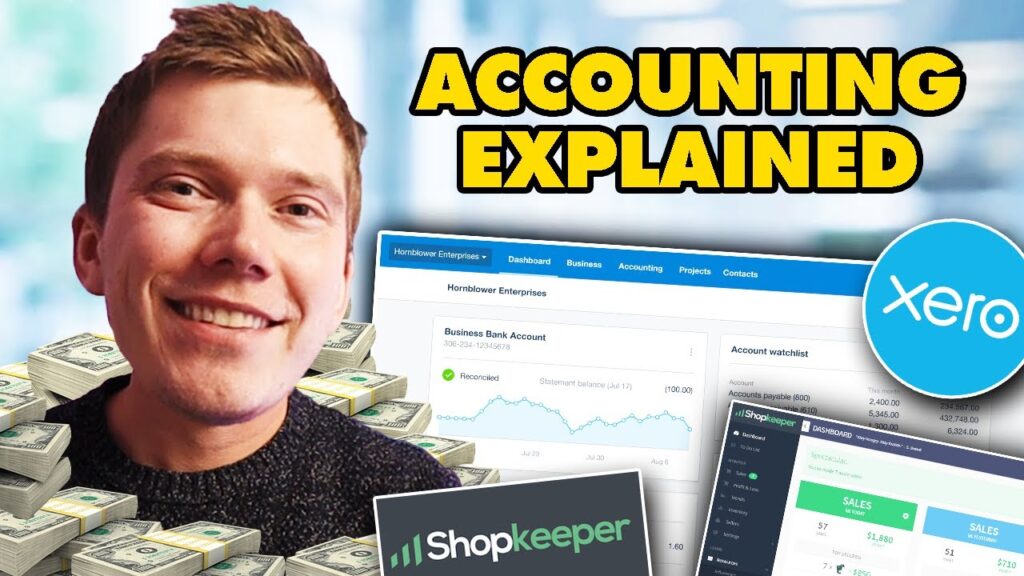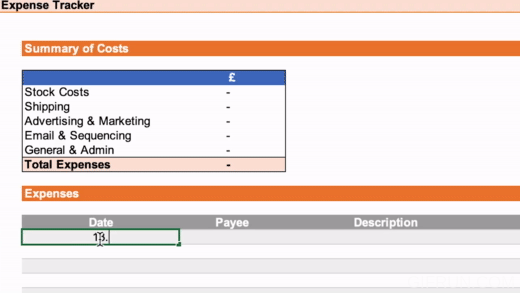
A key principle of running a successful business, is being on top of your numbers. Whether you sell with Amazon FBA, on eBay, etsy, Shopify, or anywhere else for that matter, you need to be on top of your income and your expenses so that you understand whether your business is profitable or not. In this blog post, I’m going to be running through the different Amazon FBA accounting tools and processes that I use and recommend, all of which are suitable for small business owners that sell products online.
What Online Tools I Use For My Amazon FBA Business
Free Expense Tracker (Smashers Academy)

I’ll let’s start off with my first recommendation, which is my free expense tracker.
Even if you’ve only just decided that you want to run your own business, you still need to have a system in place for noting any business expenses that you incur, all of which need to be recorded so that your accountant is able to properly calculate your profit and how much tax you owe when you actually start trading. Regardless of whether you want to run your business as a sole trader or a limited company, recording every single one of your expenses is a must not only because you’ll probably forget what you’ve spent your money on as the months pass but also because you’ll save your accountant a ton of time in understanding your financials, ultimately making your accounting bill much lower than if you didn’t.
Osome
Speaking of accountants, if you don’t have one yet or you’re not happy with the service that you’re currently getting, check out Osome, who are a digital accountancy firm that specialize in accounting for people looking to sell with Amazon FBA, Shopify, eBay and more. They have an offer if you’d like to get 2 months of free accounting and a limited company set up for you.

While there are a lot of expense tracking apps and websites out there, most of them do cost, which might not be the sort of thing you want to spend your money on at such an early stage. But that’s not going to be a problem for us because you can make use of the expense tracker that I put together and used for months on end when I first started selling products online. Simply visit jansonsmith.com and browse to my tools and resources page to download it.
As mentioned, the purpose of my expense tracker is to make your life and your accountant’s life much easier when trying to remember all of the expenses that you and your business have made over the year. Every time that you incur a cost that is related to your business, whether that be buying stock, software, marketing, advertising, or anything else, you need to record the details of it here – so that’s going to be the date, the payee, a description of what it is you’ve bought and so on.
Of course it’s also really important to record any income that your business makes, but in my opinion, if you’re going to be running a business that sells lots of items (an e-commerce, one for example) it’s going to be much easier and quicker to use one of the more advanced tools that I’ll be running through later on. For that reason, I’d recommend only using this expense tracker tool here in the early days of running your business or if you’re going to be running one where it’s really easy to keep on to top of how many sales you make on a weekly basis. In order to keep those accounting costs low, try to ensure that you update your expense tracker at least once a week, and then every month or so, send it over to your accountant along with your receipts and invoices so that they can record everything in their own files.
Xero
Once your business starts trading or you decide that you’d rather your accountant just do all of your bookkeeping for you, you’ll want to start making use of Xero, which is an accountancy software solutions for small and medium sized businesses.
In a nutshell, the way that Xero functions is that it hooks up to your bank account and Paypal account and automatically records all of your revenue and expenses, which you or your accountant will then need to categorize. Once you’ve done this a number of times and it’s learned what expense is what, it will start doing your bookkeeping automatically and all that’s required from you is a quick confirmation. If you’re running a business that’s incurring lots of revenues and expenses every month, then Xero is a complete no brainer and will allow you to spend your time focusing on more important matters, like growing your business.

In addition to doing your bookkeeping for you, Xero also assists your accountant with calculating your revenues and accounting profits and tax liability, all of which are essential for you to know if you want to maximize your business’ performance.
While Xero’s base package is pretty cheap at around £10 per month, lots of modern accountants such as Osome automatically provide it as part of their services, so make sure that you check with your accountant if you already have it before enrolling.
LinkMyBooks
Just like Apple, Xero also has an app store, and one app that I highly recommend that you get if you are an Amazon FBA, eBay or Shopify seller is LinkMyBooks, which is an app that allows you to connect Xero directly to all of the platforms that you sell on, automatically downloading details of your revenues, refunds, transaction fees, platform fees, and more.
For example, every 2 weeks as an Amazon seller you’ll get the funds from the sales that you’ve made deposited into your bank account. Without LinkMyBooks, Xero will look at that money and see it as a lump some payment, when the reality is that it probably represents payments from lots of customers after Amazon’s fees have been deducted. While knowing the composition of a lump sum payment might not sound like it matters, when it comes to calculating whether you should be VAT registered and how much tax you owe, it is hugely important.
This is exactly why out of all of the apps out there, if you use Xero or QuickBooks and you sell on Amazon, ebay, Shopify, or Etsy, then LinkMyBooks is an essential app to get, especially so because it’s very reasonably priced compared to its competitors. It very rarely needs any input from you and does everything automatically, and the customer support that you do get if you have any questions is great. Just like with Xero, if you use Osome you’ll automatically be given LinkMyBooks for free.

It’s important to note that both Xero and LinkMyBooks are tools that are predominantly there to help your accountant put together your financial statements and work out your revenues, profits, and tax liability on an annual basis, so they’re not really suitable for checking the sales and profits on a daily basis. If you need a tool for a function like that, I recommend Shopkeeper.
Shopkeeper
Shopkeeper is an app for Amazon FBA sellers that syncs directly with your Amazon account and tells you what products you’ve sold and the profit that you’ve made for over the previous day, week, or month. You can also use it for monitoring your advertising costs, inventory levels and more. If you sell more than one type of product on Amazon and have trouble calculating your daily profit, sign up using this link to try it for free for 30 days and see what you think.

If you’re wondering what the difference is between Shopkeeper and Xero, the easiest way to explain it is that Shopkeeper is a profits tool designed for Amazon sellers, giving you granularity over an individual product’s sales and profitability. On the other hand, Xero is an accounting tool made for all sort of businesses to use, which also allows you to see you overall sales and profits from more from a bigger picture point of view.
If you are a new seller to Amazon, eBay, etsy, Shopify, or just selling online, start with My Expense Tracker and remember to keep a record of all of your costs. Then, once you start growing and you progress to the stage of selling or just incurring more and more costs, upgrade to Xero and LinkMyBooks using my discount links. However, before doing that, check to see if your accountant offers them for free – just like Osome do.
That is it for my round up of accounting and bookkeeping tools, if you’ve got any questions about anything I’ve run through in this article or have your own recommendations, let me know in the comments. In relation to the topic in this post, read my 3 recommended bank accounts for Amazon FBA business.
If you want to learn how you can create an Amazon FBA business yourself, then check out my free training where I’ll teach you everything you need to launch your first product on Amazon and scale to $5,000+ in monthly profit.
Or if you’re ready to begin your journey and want to start with the best chances of success, apply to become a member of HonestFBA’s training programme where you’ll receive guidance & support from our team of 7-figure Amazon FBA seller experts whenever you need it.





